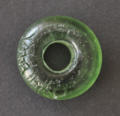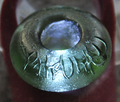BE·1
| Inscription | |
|---|---|
| Reading in transliteration: | unknown |
| Reading in original script: | unknown |
|
| |
| Object: | BE·1 Münsingen (bead) |
| Position: | top |
| Direction of writing: | unknown |
| Script: | unknown |
| Letter height: | 0.4–0.7 cm0.157 in <br />0.276 in <br /> |
| Number of letters: | 0 |
| Number of lines: | 1 |
| Workmanship: | unidentifiable |
| Condition: | complete |
|
| |
| Archaeological culture: | La Tène C 2 [from object] |
| Date of inscription: | 2nd c. BC [from object] |
|
| |
| Type: | unknown |
| Language: | unknown |
| Meaning: | unknown |
|
| |
| Alternative sigla: | none |
|
| |
| Sources: | Vitali & Kaenel 2000: 121 |
Images
|
| ||||
Commentary
First published in Vitali & Kaenel 2000: 121. Examined for LexLep on 21st July 2021.
Images in Wiedmer-Stern 1910: 11 (photo), Hodson 1968: p. 94, no. 31897 (drawings), Vitali & Kaenel 2000: 121, fig. 8 (photos and drawing = Gambari & Kaenel 2001: 34, fig. 1, plus a new drawing).
The putative inscription is applied along the circle-curve of the glass bead, somewhat above the side. The traces seen today, ca. 1 mm deep, appear to be a negative: the inscription would have been applied, either immediately after the bead was wound or after reheating the core, with glass of a different colour. (A secondary engraving on the hard bead, as implied by Rolland & Olivier 2018: 1, seems unlikely; cf. Wiedmer-Stern 1910: 11, Vitali & Kaenel 2000: 121, Gambari & Kaenel 2001: 35. Zepezauer 1993: 43 refers to the grooves as a "Gravur".) The bead was then reheated to flatten the applied lines or possibly create a smooth surface, and improve the bond; still, decorations applied in this manner are prone to falling out, leaving indents and grooves behind. Traces of the coloured glass should still be visible under a microscope, unless they were lost when the grooves were filled with a white substance for photographs, see Wiedmer-Stern 1910: 11, then at some point cleaned out again. The order in which the lines were applied can be seen quite clearly: the inscription begins with the cane-shape and ends with the Y-shape. The orientation seems intuitively evident, but is ultimately uncertain: if the bead was still wound around the original metal rod, the inscription would probably have been applied from above, viz. with the upper ends of the letters toward the hole, which is opposite to the orientation assumed for both readings.
The difficulty of the reading can be gauged by a look at the existing proposals: Vitali suggests (sinistroverse) anθine (a non-Celtic personal name with Etruscan auslaut -e); Gambari (Gambari & Kaenel 2001) went for (dextroverse) samoritos or samorikos. samoritos would here be a Celtic personal name in the nominative with second element rit-, while samorikos, though judged less probable epigraphically by the author, is otherwise attested (see p. 36 and KGP: 264 f.), and would be a genitive with second element rīg- (cf. Rubat Borel 2005: 11, n. 10, who prefers samorikos or samoriχos); in both cases, the first element is samo- 'summer' (DLG: 266). Gambari's reading is more comprehensible than Vitali's, and agrees with the writing direction proposed above. It is not, however, in absolute terms plausible. Alpha, mu and omicron are the most convincing identifications of letters, but the others are forced (especially the quasi-ligature of omicron and sigma at the end). Both Gambari and Vitali point to the difficult application to motivate the strange letter shapes, but I'm unsure whether this is warrantable: the writer clearly knew what they were doing, and achieved fairly neat, smooth lines. It seems to me that it would have been rather easier to apply the individual straight-lined letters of the Lepontic alphabet than the rounded, connected ones seen here. Insofar, the script looks more like an intentional cursive, but of what script remains open to debate. As for the question whether the lines should be considered writing at all, this is difficult to argue conclusively without a convincing reading, but it is hard to see what other function the asymmetrical shapes could have had. Irregular-looking grooves on glass can sometimes be the remains of regular decorations which did not melt into the core in all places, but this seems unlikely here, as the existing grooves do not flatten out toward the ends. Pseudo-script certainly seems a possibility. Cf. the putative Raetic/Camunic AV-1 on a small silver ring for a document with similar methodological issues.
An examination of the bead by a specialist is being discussed with the Historisches Museum (Bern). Until then, it cannot absolutely be excluded that the grooves are non-intentional, viz. cracks which appeared when the bead cooled, or glass corrosion.
Thanks to Gudrun Bajc (University of Vienna) for sharing her expertise as an experimental archaeologist and glass bead maker!
Bibliography
| DLG | Xavier Delamarre, Dictionnaire de la langue gauloise. Une approche linguistique du vieux-celtique continental, 2nd, revised edition, Paris: Errance 2003. |
|---|





